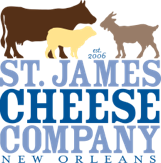
By Molly Bourg
When we think of ‘seasonal foods’, it’s easy to conjure images of bright summer strawberries and robust autumn pumpkins. But dairy is just as dependent on the rhythms of the Earth as fruit and vegetables. For every cheese there is a season.
Writer Clifton Fadiman said that cheese is “milk’s leap towards immortality.” While not completely immortal, cheese is a way of preserving plentiful summer milk for the barren winter months. If we start in the summer, we’ll see that milk is plentiful because grass and vegetation are plentiful. The more fresh feed a dairy animal has, the more milk she produces. The milk itself is also higher quality. The various grasses, herbs, and flowers that the animals graze on will transfer flavors and aromas to the milk. Summer milk is considered to have the best depth of flavor because of the variety of plants in the animal’s diet. In cow’s milk specifically, you can tell if the animal has had a rich summer diet by the color. Cows cannot fully process the pigments in grass. If a dairy cow has had access to lots of fresh vegetation, the resulting cheese and butter will be a deep golden yellow.
Our ancestors would want to capitalize on this high quality milk, and tucked most of the cheese away to age until winter. If they wanted cheese on the menu in the meantime, fresh cheeses like feta, mozzarella, cottage cheese, and fromage blanc could easily be made and consumed on the same day. These cheeses are light, making them perfect for hot weather. Even nowadays we see their use in summer recipes. Think of fresh mozzarella and heirloom tomatoes in a caprese, or a watermelon and feta salad.
In the autumn we see a slow down in milk production. For goats and sheep, autumn marks the end of milking season and beginning of the mating season. This way the animals are pregnant through the winter and give birth in spring, reducing the chance of having a baby exposed to the cold. Most commercial goat cheese bought in the fall and winter is made from summer milk that has been frozen and then thawed. Cows will also see a decrease in milk production, as they need to save calories for survival. The milk itself changes as the animals’ diet adjusts. Fresh grass is slowly swapped for hay and grain, which are far more calorie dense and will keep the animal warm and healthy. Those extra calories roll over into the milk, making it higher in fat. Spruce wrapped cheeses like Vacherin Mont d’Or and Rush Creek Reserve are traditionally made in the autumn and winter to take advantage of the fat bomb milk. The cheeses are so decadent that they must be girdled with tree bark to stabilize their ooey-gooey center.
In the winter the months of hard work have finally paid off. Firmer alpine styles, goudas, and clothbound cheddars have now had time to mature and develop, providing a tasty source of protein and fat during the dreary winter months. Certain cheeses like Stilton age for around six months, meaning they would be ready just in time for Christmas and were historically featured in holiday meals. Mountain cheeses like Gruyere, Comte, and Raclette melt beautifully over cold weather staples like root vegetables and cured meats. Many artisan dairy farmers will “dry off” their herd in the winter. A “dried off” herd will not need to be milked for several weeks, giving both the farmers and the animals some well deserved rest.
As spring begins to break, the world comes alive again. Lambing and kidding season begins, and goat and sheep’s milk cheese explodes back into production after a long winter hibernation. The fresh chevre pairs with the peas, asparagus, mint, and parley popping up in spring gardens. The farmers must look at their stock to see what, if any, cheese remains from the long winter and begin preparations to start the cycle anew.
